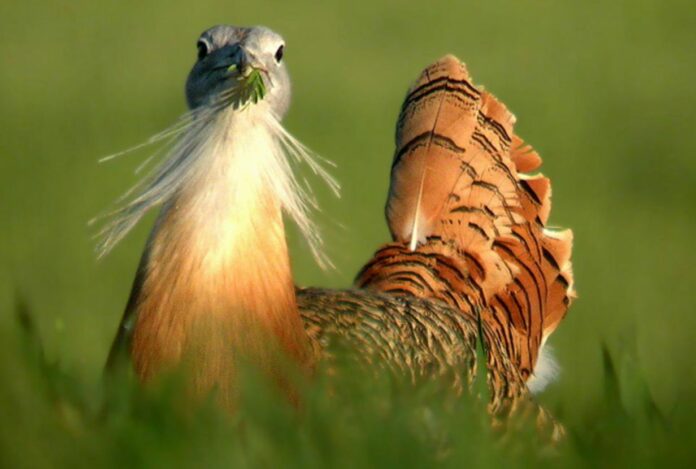Self-medication is not something that is unique to humans only. Birds, bees, lizards, elephants, and chimpanzees are just some of the animals that have been observed to exhibit this behavior.
Now, however, a study published in Frontiers in Ecology and Evolution reveals that great bustards have another reason to pique our interest: they actively seek out two plants that contain substances that kill diseases. They may therefore be a unique example of a bird that uses plants as self-medication to fight disease.
First author Dr. Luis M Bautista-Sopelana says: “Here we show that great bustards prefer to eat plants with chemical compounds with antiparasitic effects in vitro.”
“Great bustards,” according to co-author Dr. Azucena Gonzalez-Coloma, “seek out two species of weeds that are also used by humans in traditional medicine. We show that both contain antiprotozoal and nematicidal (ie, worm-killing) compounds, while the second also contains antifungal agents.”
Great bustards, listed as Vulnerable on the IUCN Red List of Threatened Species, breed across Europe, Africa, and Asia.
Iberia has 70% of the world’s population. Females usually stay on the home range where they hatched for the rest of their lives, which is 10 to 15 years. Males, on the other hand, move away but return to the same lek site every year.
They run the risk of reinfecting themselves by staying (and, more critically, pooping) in the same place for an extended period of time. During mating season, males need to be very strong, which is thought to make their immune systems weaken.
“In theory, both sexes of great bustards,” as explained by Gonzalez-Coloma, “might benefit from seeking out medicinal plants in the mating season when sexually transmitted diseases are common, while males that use plants with compounds active against diseases might appear more healthy, vigorous, and attractive to females.”
Some members of the current research team have been studying great bustards since the early 1980s, mostly in the Spanish areas of Madrid and Castilla-León.
A total of 623 feces were collected from both male and female great bustards, with 178 of those being taken in April during mating season.
They used a microscope to count the amount of stem, leaf, and flower tissue from 90 plant species that grow in the area and are known to be eaten by bustards.
The findings revealed that two species, corn poppies, Papaver rhoeas, and purple viper’s bugloss, Echium plantagineum, are eaten by great bustards more frequently than expected based on their abundance.
“Great bustards select corn poppies and purple viper’s bugloss mainly in the mating season, in April,” adds Bautista-Sopelana, “when their energy expenditure is greatest. And males, who during these months spend much of their time and energy budgets on sexual display, prefer them more than females.”
The first of these two species is ignored by cattle and is used as a pain reliever, sedative, and immune booster in traditional medicine. If consumed in large quantities, the second is poisonous to both people and livestock. They are also nutritious: corn poppy seeds are high in fatty acids, while purple viper’s bugloss seeds are high in edible oils.
With the help of gas chromatography-mass spectrometry (GC-MS) and liquid chromatography-mass spectrometry (HPLC-MS), the authors extracted water- and fat-soluable chemicals from both species. They concentrated on the lipids, volatile essential oils, and alkaloids that many plants make to protect themselves from herbivores. For instance, they discovered that the bioactive alkaloids rhoeadine, rhoeagenine, epiberberine, and canadine are abundant in corn poppies.
The team next evaluated the activity of the isolated molecular fractions against three prevalent avian parasites: Trichomonas gallinae, Meloidogyne javanica, and Aspergillus niger.
The findings demonstrate that purple viper’s bugloss is also somewhat active against fungus, whereas extracts from both plants are highly effective at inhibiting or killing protozoa and nematodes in vitro.
The authors believe that great bustards are excellent examples of birds that actively seek out medicinal plants. But, they say, more research is needed.
“The ultimate proof of self-medication,” adds Bautista-Sopelana, “requires experimental protocols developed in the biomedical, veterinary, and pharmacological sciences.”
“Until then, we continue with our fieldwork. For example, quantifying the prevalence of remains of corn poppies and purple viper’s bugloss and pathogens in fecal droppings across different populations of great bustards could falsify our hypothesis of self-medication in this species.”
Image Credit: Carlos Palacín
